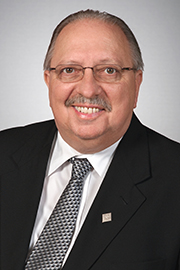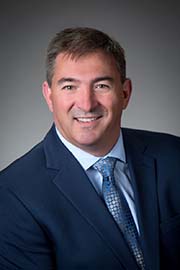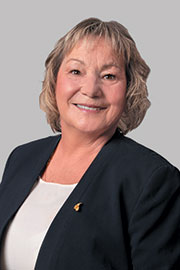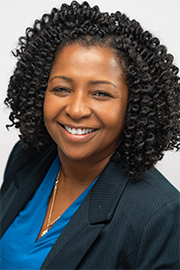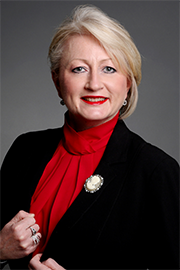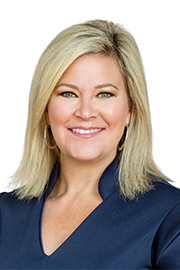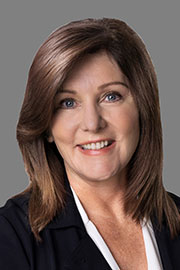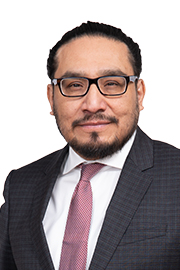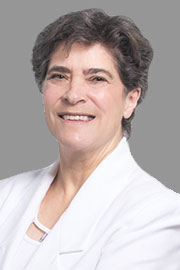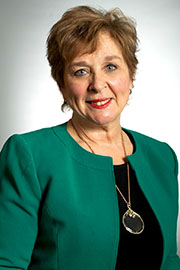- May/10/23 4:30:00 p.m.
I will say that the committee hasn’t yet started to look at the specifics. But much of what is going to come, I think, from the secretariat is hopefully a bit of a back and forth so that the committee can be useful in specific ways and then broadly useful, yes. But we don’t have an idea of where we would be going as a committee. There are folks looking into options.
But what you have flagged I think is—at the forefront of everyone’s minds is that we want to do this well. The people who we’ll be consulting will have far more expertise than I or than others. You run into people who say, “Oh, you know where you should move? You should move to this building, or that building, or maybe Ontario Place”—just kidding, too soon?
But I would say that wherever we go, it’s going to end up being hopefully well-planned, and that’s part of the work of the secretariat, to do this in a way that takes the time it deserves.
Really, at this point, it’s learning from precinct properties. They have heard every complaint from all of us, and they have done their best to accommodate that. So what are some of their recommendations for during the transition and the next space and then the space after that, which would be to come back here? I’d say that we are looking forward to doing that work well. If anyone has an expert in their back pocket, send them our way.
- Hear!
- Rabble!
- May/10/23 4:30:00 p.m.
The stenos.
- Hear!
- Rabble!
- May/10/23 4:30:00 p.m.
To the member from Oshawa: The building was first opened in 1893. It has served the people of Ontario very, very well. But one of the things that we see in it—and I know it has been talked about already and some questions asked about it already—is when you look at the grandeur of this building, when you look at the style of everything, no one in 1893 took into consideration that there may need to be accommodations made for different people, whether it’s mobility challenges, whether it is audio, whether they have challenges with their eyesight. None of that was thought of in 1893 because that’s not what the world was thinking of.
Has thought been given to making changes so that we are accommodating a lot of other things that weren’t considered in 1893?
- Hear!
- Rabble!
- May/10/23 4:50:00 p.m.
To the member from Etobicoke–Lakeshore: As you spoke, you spoke about how mystical this place is, how magical it is. I often FaceTime my granddaughters in Halifax and say, “Grammy is at her castle again.” When you talked about the gargoyles outside and the history that’s in this building, you made it sound so wonderful—which it is.
Right outside my office on the third floor is that wonderful, large stained-glass window. When the sun came in today, it just made me feel just as proud as you and every member in this place that we do have a seat here. We are privileged to be here to serve the people in our ridings.
Now this building, as I said, has tremendous history, and the future of the Queen’s Park restoration and renovation is a perfect opportunity to be able to do it right. What are some of the things that you think the committee might be able to join together and express how we can keep some of the history here for the future?
- Hear!
- Rabble!
- May/10/23 4:50:00 p.m.
Question?
- Hear!
- Rabble!
- May/10/23 4:50:00 p.m.
I’d like to thank the member for her presentation. Recently, on the day to acknowledge missing and murdered Indigenous women, girls and two-spirited individuals, I had the opportunity to attend my alma mater, Althouse College, who had taken and repurposed their library into an Indigenous learning space as well as an outdoor area.
Specifically, we are sitting on quite a vast footprint here at Queen’s Park. My question to the member: How would you like to see the outdoor space reimagined to include Indigenous peoples? How can you foresee us making sure that this is a welcome and open space, building on those relationships?
- Hear!
- Rabble!
- May/10/23 4:50:00 p.m.
Thank you to the member from Etobicoke–Lakeshore for her speech. I have to say, it has been a privilege sitting on the committee for procedures and House affairs with you, under the chairperson as well.
I appreciated all the speeches. One thing that I’ve heard, a common thread, and I’d like to see if you could elaborate on that, is when it comes to technology and our, how shall I say, technology challenges currently in this building—I think we’ve all experienced it; in certain places, you can’t get WiFi.
Talking about the future, and even when we were in Ottawa and seeing how they did up the current chamber with technology and what the future may hold—if the member could elaborate on her thoughts on our challenges currently and into the future related to technology.
- Hear!
- Rabble!
- May/10/23 4:50:00 p.m.
Thanks for the question. I think everything is on the table right now. We’re having those discussions. We’re just really in the early stage.
I think the most important thing is consultation. It’s not for a small group of us to make those decisions. This is Ontario’s place. This is for Ontario. This is for Ontarians. This is for future politicians and parliamentarians. Certainly I’d love to do a design, but it’s not just about me. It has certainly never been about me. It’s about our communities. It’s about all of us. It’s about our history. It’s about our future.
Any type of information that they would like to share, please share it with the committee, because I think we all have something to say on how we’re going to make this place even better than it is today.
I actually have to applaud the staff. The staff who work here have done a phenomenal job making this work. I’m sure they all walk around with a roll of duct tape—my goodness, some of the stuff that you’d think was duct-taped together. But they’ve done a phenomenal job to make sure that we can debate; to make sure that these lights allow the proper lighting to come down, so when the cameras are rolling, we’re seen; the work that they do to make sure that when we’re called upon, our speaker comes on; and the translation, so we can certainly have our debate in multiple languages for those francophones in our province.
Technology is certainly something that is important, and it’s also the future. I think I was on the top floor, the third floor, when we saw the one room where a lot of the tech—I guess the background, where they have all the knobs and tubes and all that type of business. There’s lots of work to be done at the technology stage. All you have to do is go into any of these offices, and you will see a lot of cable, and none of that cable is even used today.
- Hear!
- Rabble!
- May/10/23 5:00:00 p.m.
Thank you, Speaker, and thank you to the member for Etobicoke–Lakeshore for her remarks. I enjoyed listening to stories about your family and stories about when you worked here in the 1990s, and I’m just wondering if you might take a moment or two and tell us about some of the changes you’ve seen in the building since the 1990s and if they’ve been effective.
- Hear!
- Rabble!
- May/10/23 5:00:00 p.m.
That’s a great question, because I think one of the most important things is to not lose what is here, and one of the things we saw when we were on Parliament Hill was that every piece was actually numbered, brought somewhere and then stored somewhere so it could be put back when the time came. So, that’s all going to be part of the decanting, and that’s why it’s such a large project, because they do want to take it out, they number them and then they’ll put them back in place. So we can’t—you are right. For your granddaughter and everyone’s grandchildren, we can’t lose what we have. It has to be remembered and the engineers have a system in place to make sure that that does happen.
Well, as a staff member, you have a little bit more time on your hands, so you’re running around and seeing the stairwells. What changed is the roof; it’s changed, and I believe there was—this was red at one time, if I’m not mistaken. The carpet was red. So that changed, and some of the chairs are newer.
When it comes to the offices, I remember there were vaults in some of the offices in this place, which is pretty cool because we used to have a party in the vaults down the hallway there. There were actual vaults, and at one point I think that’s where the money was, although this place doesn’t have any money.
So, what has changed? Well, technology, of course, has changed. We were not allowed cellphones. No one could have a cellphone or a computer. As staff, my goodness, BlackBerrys didn’t even exist. I remember we had pagers, so they’d have to find us. If you wanted to reach your member, as staff you actually had to send notes in. You couldn’t text them automatically. Certainly technology has changed, and what’s allowed here as an MPP now versus then is twofold. That didn’t even exist at the time.
That’s just in a short period of time. Imagine what’s going to happen in 20 years. Technology’s going to change so much. We can’t answer all those questions because it’s yet to come. So we have to be prepared for the future.
Certainly we want to keep it within cost. We don’t want the cost to go skyrocketing, but there should never be a “let’s not look at something.” I think this is an opportunity to get it right. We’ll want to take our time and look at it, and we want advice from everybody. As we’ve said, it’s important to get it right because it’s not about us; it’s about the future. So let’s continue those conversations.
- Hear!
- Rabble!
- May/10/23 5:00:00 p.m.
Meegwetch, Speaker. I’m very honoured to be able to speak on Bill 75.
We know this place was not built for people who look like me. As a First Nations person, as the First Peoples of these traditional territories and our ancestral lands—I guess, first off, I’d like to welcome everyone to our territories, to these lands that we now call Ontario.
I’ve been here close to five years, and when I first came, I didn’t feel at home. I knew that this place was a colonial place.
Coming from a northern reserve, being born in an Indian hospital—actually, in Sioux Lookout, we had two hospitals. Sioux Lookout had about 4,000 or 5,000 people, and we had two hospitals. One was a federal hospital, and the other one was a provincial hospital. The provincial hospital was for white people. The federal hospital was an Indian hospital for people like me, so that’s where I was born. And then I had to go up to my reserve, which is a small—at that time, it was probably 200 or 300 people. I had to go to school. I started kindergarten there, and I finished grade 8 there. When I went to school, I started learning about the ABCs, the language, the colours—it was in kindergarten. They call them Indian day schools now—and it’s that approach to, where I should not learn about my ways of life, my language. And then, I had to leave for high school, because we don’t have that school.
I’m just sharing this, Speaker, because it will go into what I think should be part of the changes to this building.
Then, I went to grade 9, and I went to a Mennonite school—and through that whole time, there were things that were happening that I thought were acceptable, but later in life, I found out that it was actually an Indian residential school. I moved out of there, and I went to a public school in Sioux Lookout, Ontario, which is where I live right now, and the name of that school was Queen Elizabeth District High School.
So there’s all this colonialism you see, and it becomes a way of life.
The land that, again—and going back to here—makes up what we now call Ontario includes traditional territories and multiple treaty territories. I always talk about treaties in this place. Again, some are shared, but I think the ones that most people are familiar with now have towns and cities in them—including this place, where Queen’s Park is, where Toronto is.
Queen’s Park is on the traditional territory of the Mississaugas of the New Credit First Nation, but the people of this nation do not live here. Their First Nation is over 100 kilometres away from Queen’s Park. These are stolen lands. These lands have been taken from First Nations. When I’m here, I’m always reminded of, it has always been the aim of most legislation in Canada’s history and Ontario’s history, including—it was to displace First Nations people from their lands. That’s why I grew up on the reserve. Reserves were created to take away people from their traditional territories. Reserves were created to put us on a small piece of land where we are provided with access to housing, access to health care, and to take away the people from these lands and the resources that are in those traditional territories. That’s how it displaces people.
Right now, I think on-reserve you’ll see the high rates of language loss, dependency on government, dependency on other things such as welfare. We never created welfare. There was never welfare before we had reserves. We were surviving on our own until we were placed on-reserve.
One of the ideas I always talk about as well is about Indian residential schools. We know that Indian residential schools in Canada and Indian residential schools in Ontario are one of the country’s most shameful legacies. These places were church-run. I went to a Mennonite school, and they strapped people, those Mennonites. Even though they pray to their God, and they hold—you know, they do things and they still did the things that they did. We were forced to cut our hair. We weren’t allowed to speak our language. They were government-funded institutions that Indigenous children, against their will and subject to—again, I talked about some of the abuse, the neglect, the dangerous living conditions, again to further the goal of assimilation, which is Canadian culture, religion. That’s what colonizers considered civilized.
I’m not supposed to be here, but I am here. I talk about that, and I think those are some of the things that when we start developing the concept on how we’re going to make this place more real, where you share the truth-telling stories of the real history of Canada—again, these schools I talk about are just one of the many tools that were used to displace us from our lands by removing the language, by removing the children.
Even in this place, I cannot even speak my language. If I started speaking my language to you, you would stop me. I know it. It’s just that way. But I know it’s not individually to you. This place does not accept me as a First Nations-language person. I cannot even speak it. It’s not allowed. That’s how it works, where it makes sure that I have no connection to my lands, to who I am as a First Nations person from northwestern Ontario, from Kiiwetinoong, from my reserve. There’s no connection to my language. There’s no connection to my way of life. Language is a way of life.
Speaker, I don’t really have time to say more about the Indian residential schools, but, collectively, I think there are many people still working for justice for the survivors of residential schools, and not only that, but for their families, who are still recovering, generations later.
One of the methods of learning we needed to be done for justice for the survivors was the 2008 creation of the Truth and Reconciliation Commission, a government-sanctioned body that spent years hearing testimony from residential school survivors within First Nations, within Métis, within Inuit communities, compiling the accurate report on the atrocities committed and the intergenerational effects of Indian residential schools.
The systems of colonialism are not broken; they’re working exactly the way they’re designed to, which is to take away the rights of the people whose lands we live on today. I know recommending far-reaching policy changes and fostering comprehensive educational programs would prevent such atrocities from ever happening again.
Speaker, I would also like to say that when the Truth and Reconciliation Commission released its final report in 2015—only eight years ago—it recommended 94 calls to action for the Canadian government to right the wrongs that have been done to Indigenous people. It was only the first step to begin dismantling the systemic racism, to stop the oppression, to stop the colonialism that has devastated our people as First Nations.
This is very relevant to what we’re talking about today, because what we have in this building is history. It’s your history. I don’t see any history of First Nations people here. There might be a painting up there. We have a room of First Nations paintings in 228 and 230. I look around this place and I only see one aspect of Ontario’s history. That’s your history.
This building is a physical representation of heritage and commemoration, but shouldn’t all Ontarians be able to look around and see themselves here at Queen’s Park, in this place where we say, “everyone’s House”? First Nations people—we are people too. We are from Kiiwetinoong. We are the Oji-Crees, we are the Ojibways, we are the Crees. We are all over. We have been here since time immemorial. We’ve been here for thousands of years.
“What is it like for you to be in this building?” I ask myself that. People ask me that. Sometimes I say, “It’s so colonial here.” It is for me. But where do we see ourselves as First Nations people in this building, when we start the work of this restoration of this building? I think that with this act this government has an opportunity to implement call 79 and call 82 from the Truth and Reconciliation Commission. Call 79 says:
“We call upon the federal government, in collaboration with survivors, Aboriginal organizations, and the arts community, to develop a reconciliation framework for Canadian heritage and commemoration. This would include, but not be limited to:
“(i) Amending the Historic Sites and Monuments Act to include First Nations, Inuit and Métis representation on the Historic Sites and Monuments Board of Canada and its secretariat.
“(ii) Revising the policies, the criteria and practices of the National Program of Historical Commemoration to integrate Indigenous history, heritage values and memory practises into Canada’s national heritage history.
“(iii) Developing and implementing a national heritage plan and strategy for commemorating residential school sites, the history and the legacy of residential schools and the contributions of Aboriginal peoples to Canada’s history.”
That’s Call 79 from the Truth and Reconciliation Commission.
“Call 82,
“We call upon provincial and territorial governments, in collaboration with survivors and their organizations, and other parties to the Settlement Agreement to commission and install publicly accessible, highly visible residential school monuments in each capital city to honour survivors and all the children who were lost to their families and communities.”
That’s what we need to do. That is the real history of Ontario. That is the real history of Canada. There’s an opportunity there.
To all the pages who are here, they are the change-makers. The kids—I know they’re listening. I know they do not understand that history that we didn’t learn.
There is an opportunity here in this bill to build on these calls and make sure that there’s a recognition of not just Indigenous people but our history, our real history.
We need to make sure that this act integrates Indigenous history, heritage values, our languages and memory practices into Ontario’s heritage and history that we see in this building. This can only happen with First Nations’ full consultation. This can only happen with our input, with First Nations’ input. We have to be able to see ourselves in this building. We have to be able to see that we are part of this place.
One of the things that I see—a very minor change—is the carvings up above the main entrance to the chamber. We have the wolf that speaks about humility; we have the beaver that speaks about wisdom; we have the bear that speaks about bravery; we have the turtle that speaks about truth; we have the raven that speaks about honesty; we also have the buffalo that teaches respect; but most importantly, we have the eagle as well that teaches you love.
Sometimes when I listen to everybody here doing business, especially during question period, you are not following those teachings. There might come a day if you continue that way when First Nations will ask for that back because you’re not respecting it. Meegwetch.
- Hear!
- Rabble!
- May/10/23 5:00:00 p.m.
I wonder if we could just have a little imaginative exercise. So the Minister of Northern Development mentioned earlier the idea of possibly having a movable Legislature, which I think is a very interesting thought, especially if we don’t think about the cost or the mechanics, but the idea of it. I wonder if we could think also about language. English and French were made as the official languages of Canada as a colonial state. What if we were able to hear Cree, Oji-Cree, Ojibway, Mohawk? How would things have been different if those languages and thought processes had been part, and is there a way we can incorporate that into our future?
- Hear!
- Rabble!
- May/10/23 5:00:00 p.m.
Further question?
- Hear!
- Rabble!
- May/10/23 5:20:00 p.m.
Certainly. Meegwetch for that question. I think it’s always important to listen to people, listen to First Nations. Again, typically, we are not listened to in this place. In this provincial Legislature, Queen’s Park, government, sometimes things are done in a way that makes it look as if they’re doing something without really doing anything. They give us the minimal stuff. That’s not acceptable anymore. You cannot be 10% colonial. You might as well be 100% colonial. I think it’s important to have some type of Indigenous group that you will be able to engage with, and that you will listen to us.
- Hear!
- Rabble!
- May/10/23 5:20:00 p.m.
Thank you to the member opposite, the member from Kiiwetinoong, for his comments, which I enjoyed listening to. The member mentioned that we don’t see Indigenous peoples reflected here and that we have an opportunity with this legislation to be able to see Indigenous peoples reflected here. I would say that I think we’ve made a little progress on that. We have the Seven Grandfathers—is that what they’re called—and we also have the member from Kiiwetinoong himself here, so some Indigenous people will see some reflection of themselves. What else would you suggest we can do in a reimagined Queen’s Park or Legislative Building?
- Hear!
- Rabble!
- May/10/23 5:20:00 p.m.
A lot of people are going to have a lot of suggestions as to what they would like to see in a redesigned Queen’s Park and in a redesigned legislative precinct. Some people will want various different things, and then those suggestions will have to be vetted and some kind of decisions will have to be made. So I’d like to invite the member from Kiiwetinoong to give us his idea of what would be the mechanism or the way suggestions would be received and then discussed or vetted and then decisions would be made. If he can give us an idea of what he thinks about that.
- Hear!
- Rabble!
- May/10/23 5:20:00 p.m.
I appreciated being here and listening to your remarks. I have so many thoughts. I’m going to try and distill it down. One of the things that you had said was about making this place more real, telling the real history of Canada, and I think history is a big part of when we look around this place. It is a big part of the story, but I also think that the future and the next chapter is an important part, because it’s one thing to say that everyone is welcome here, but that feels very polite. That we open the doors and say, “You are allowed in,” that’s about permission and manners. It’s a very different thing to say that people belong here. How can we approach this process to ensure that more people belong in this space?
- Hear!
- Rabble!
- May/10/23 5:20:00 p.m.
Questions?
- Hear!
- Rabble!
- May/10/23 5:30:00 p.m.
Thank you for your presentation. I’m wondering, really, if we were observing the Seven Grandfather Teachings, what it would look like in the decision-making process. We had a decision made today about a mining bill, and it was objected to by the nine First Nations of Matawa, by the Chiefs of Ontario, 131 First Nations, by members of Treaty 9 and Whitesand—
- Hear!
- Rabble!
- May/10/23 5:30:00 p.m.
I think it’s important to acknowledge some of the things that we see—the paintings. I go to some offices and when I try to get Indigenous art or woodland art in my office, most of it is taken, and it’s taken by other MPPs, it’s taken by other offices. Reconciliation is not having woodland art in your community. That’s not reconciliation. We need to be better than that. But I think it’s important to, again, commission and install—publicly accessible, highly visible—a residential school monument on the grounds. Meegwetch.
I think we would be able to move forward in a good way together as a—not First Nations, not as parties, those party lines that sometimes we don’t agree upon. I think we would be able to move things further, to have better communities, to have a better province, but also a better Canada. Most importantly, I think if we work together—we always want the same thing, and that’s to have a better society. Meegwetch.
I think it’s important, again, to acknowledge some of the historical practices, the historical things that have been done to, again, First Nations. And if it was up to me, if I had the translator in the box that could speak my language, I would really like that.
- Hear!
- Rabble!



